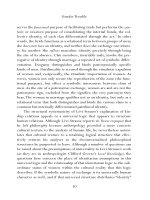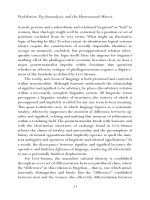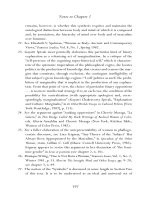GENDER TROUBLE 23
Bạn đang xem bản rút gọn của tài liệu. Xem và tải ngay bản đầy đủ của tài liệu tại đây (20.41 KB, 1 trang )
Gender Trouble
What continues to concern me most is the following kinds of
questions: what will and will not constitute an intelligible life, and
how do presumptions about normative gender and sexuality determine in advance what will qualify as the “human” and the “livable”? In
other words, how do normative gender presumptions work to delimit
the very field of description that we have for the human? What is the
means by which we come to see this delimiting power, and what are
the means by which we transform it?
The discussion of drag that Gender Trouble offers to explain the constructed and performative dimension of gender is not precisely an example of subversion. It would be a mistake to take it as the paradigm of
subversive action or, indeed, as a model for political agency.The point is
rather different. If one thinks that one sees a man dressed as a woman or
a woman dressed as a man, then one takes the first term of each of those
perceptions as the “reality” of gender: the gender that is introduced
through the simile lacks “reality,” and is taken to constitute an illusory
appearance. In such perceptions in which an ostensible reality is coupled with an unreality, we think we know what the reality is, and take
the secondary appearance of gender to be mere artifice, play, falsehood,
and illusion. But what is the sense of “gender reality” that founds this
perception in this way? Perhaps we think we know what the anatomy of
the person is (sometimes we do not, and we certainly have not appreciated the variation that exists at the level of anatomical description). Or
we derive that knowledge from the clothes that the person wears, or
how the clothes are worn.This is naturalized knowledge, even though it
is based on a series of cultural inferences, some of which are highly
erroneous. Indeed, if we shift the example from drag to transsexuality,
then it is no longer possible to derive a judgment about stable anatomy
from the clothes that cover and articulate the body. That body may be
preoperative, transitional, or postoperative; even “seeing” the body may
not answer the question: for what are the categories through which one sees?
The moment in which one’s staid and usual cultural perceptions fail,
xxii









